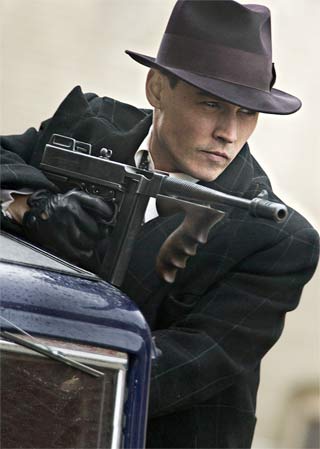Public Enemies
That Desperado, he's got his reasons
Last year, director Michael Mann took a cast and film crew to northern Wisconsin to shoot location scenes for Public Enemies, his opus about notorious Depression-era bank robber John Dillinger at the Bohemian Lodge resort, where in 1934 Dillinger escaped an attempt by the FBI to capture or kill him. Crime-history buffs travel to this area to see the still operating lodge, largely unchanged down to the preserved bullet holes in windows and walls.

Public Enemies is in a couple of respects a nostalgic movie. It’s happily immersed in the look and feel of the 1930s, and it’s also a kind of limited homage to the old gangster and romantic criminal movies that were once a staple of movie fare. The story of Dillinger (Johnny Depp) and his short but celebrated career as a Midwestern bank robber is an authentically American one, with more than one kind of historical importance.
For a couple of years, Dillinger frustrated local, state and national law enforcement as he robbed banks while assuring patrons and bystanders he meant them no harm. Along with other criminals of national repute, he became the object of a revitalized FBI and an unintentional contributor to bureau director J. Edgar Hoover’s awe-inspiring, and rather fabricated, public image. Until his eventual end outside a Chicago movie theater, Dillinger was a kind of news-media-created folk hero, a persona he consciously helped to create and cultivate. Dillinger and others who became the objects of Hoover’s systematic and sometimes brutal “War on Crime” even came to be viewed as threats to the reputation of FDR’s New Deal, and the president sternly warned the public about valorizing criminals rather than peace officers.
All this and much more is in Bryan Burrough’s book of the same title, the basis for the movie. Mann and company (he co-wrote it with Ronan Bennett and Ann Biderman) mostly follow the sections of the book dealing with Dillinger’s last two years, though they turn to invention and hyperbole at certain junctures.
Their movie interweaves two major themes and a secondary one. First, there’s the bitter but often botched pursuit of Dillinger and his gang by Hoover’s agents, led by the head of the Chicago office Melvin Purvis (Christian Bale, occasionally straining to maintain a Southern accent). The movie’s Purvis is a rather tailored, bowdlerized, and improved-on character, but the real problem is that he has no real heft or personality.
The intimate heart of Public Enemies is the story of Dillinger’s love for Billie Frechette (last year’s Oscar winner Marion Cotillard), a Chicago hat-check girl.
Mann has made an addition that’s not in Burrough’s story: He attempts to explain Dillinger and his fate partly by posing a growing and dangerous antipathy to Dillinger and other independent criminal entrepreneurs by the Chicago mob as it began to worry about increased scrutiny and prosecution by the new, enlarged federal law enforcement efforts engendered by the crime wave in the American heartland. This may be largely fictional, but it’s an interesting idea: the combined institutionalization of crime and law enforcement operating against the enterprising small-scale outlaw.
Despite the movie’s core love story, Public Enemies usually works better on a large-scale than on a more intimate level. Part of the problem is Depp’s oddly muted performance. An actor who has easily indulged in the eccentric (as Willy Wonka), the flamboyant (in Pirates of the Caribbean), and the passionately ugly (as Sweeney Todd), he here seems to be holding himself in reserve much of the time. He has a star’s presence, but the performance is mostly carefully maintained surfaces. Cotillard has more intensity. Part of the problem is in the script, which never seems to create a vital portrait of this roguish crook and killer.
This lack hardly sinks the movie; it’s an involving, sometimes poetically sensual and kinetic experience. From the opening scenes, placed below a vast cloud-interrupted expanse of sky over the bleakly handsome plains landscape, the geography has the feel of a physical presence in the movie. Later, this physicality is less obvious, but Dante Spinotti’s striking digital photography is never less than persuasive. (The film is less convincing aurally with its anachronistic inclusion of Diana Krall and Billie Holiday on the soundtrack.)
Mann is a minor master of pacing, editing, and composition, and Public Enemies never really flags, even when it stops for short scenes of lovemaking or criminal conferences. The bank heists and shootouts, particularly Dillinger’s escape from the Bohemian Lodge, are viscerally exciting and have a kind of stark beauty, aided by Spinotti’s tenebrist lighting effects. Mann has achieved a fair amount of the mythically romantic feel he was aiming for. Public Enemies is one of the most intelligent, aesthetically inciting big action pictures of recent years.
—george sax
Watch the trailer for Public Enemies
blog comments powered by Disqus
|
Issue Navigation> Issue Index > v8n27 (Week of Thursday, July 2nd, 2009) > Film Reviews > Public Enemies This Week's Issue • Artvoice Daily • Artvoice TV • Events Calendar • Classifieds |









 Current Issue
Current Issue